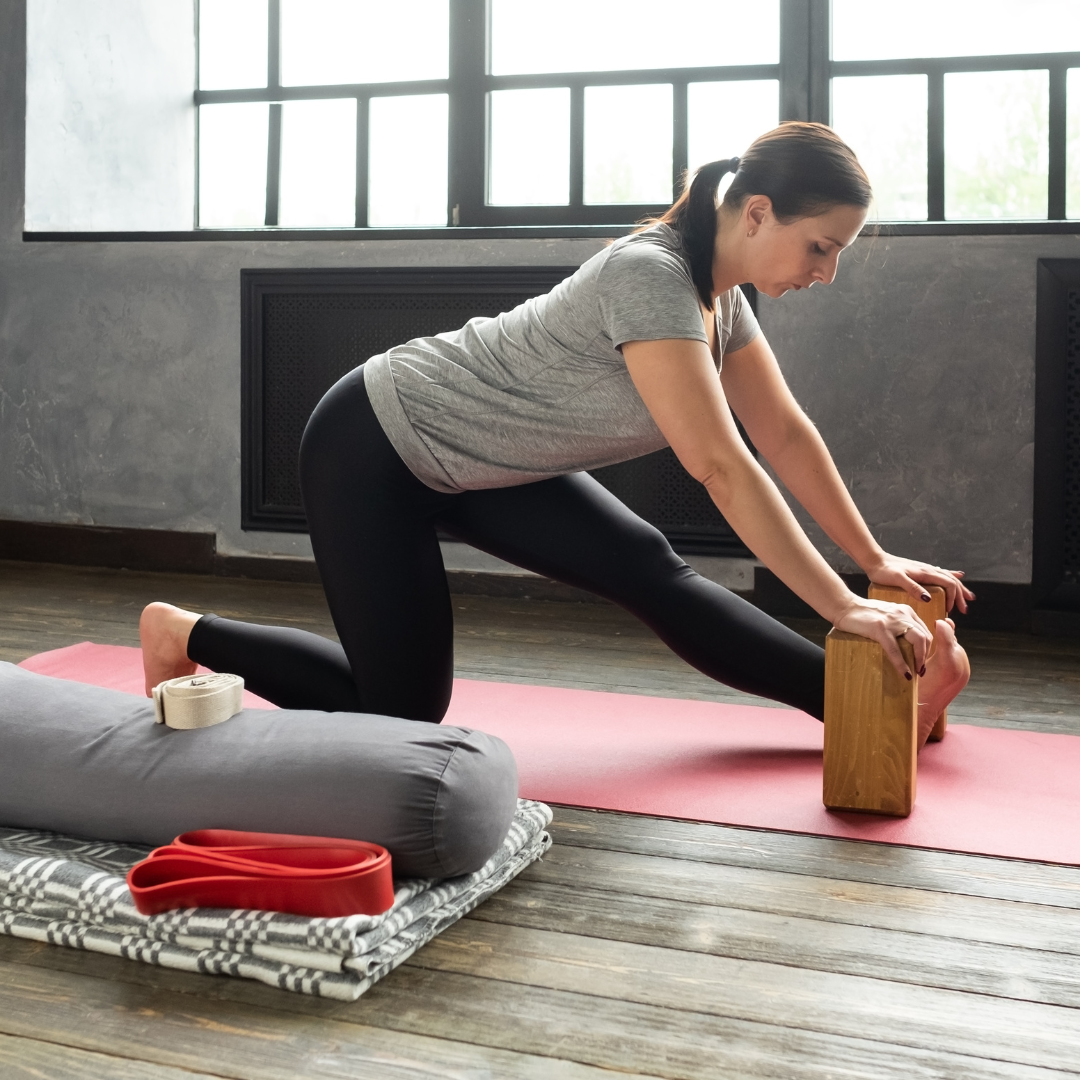Do you feel like your whole yoga practice needs to change now that you’re pregnant?
It will in some ways, but you can find wonderful substitutions for many poses!
These substitutions are generally known as yoga modifications and they are used to suit the physical needs and accommodations of your changing pregnant body.
Let’s dive in!
Navigation
- What is a yoga modification?
- Who should do yoga modifications?
- Easy yoga modifications for pregnancy
- Yoga modifications for sacroiliac joint (SI) pain
- Yoga modifications for SPD (symphysis pubis dysfunction) pain
- What kind of props do you need for yoga modifications?
- Yoga is still enjoyable during pregnancy
- FAQs
What is a yoga modification?
A yoga modification is an altered traditional yoga pose to suit a particular physical need or to avoid exacerbating an existing physical condition. Prenatal Yoga uses both particular yoga modifications and safe traditional yoga poses to suit the demands of the pregnant body. These modifications are done by either altering your positioning slightly or by using yoga props such as blocks and bolsters for extra support.
Who should do yoga modifications?
Generally, Prenatal Yoga already contains both modified poses and traditional yoga poses that are suitable for pregnant people but occasionally folks will find that certain poses exacerbate pregnancy-related ailments such as sacroiliac joint (SI) pain or symphysis pubis dysfunction. (SPD) .
In this case, certain poses may need to be further modified in order for the pregnant person to feel comfortable doing this pose and avoid worsening the issue. This may mean that they need to use additional props or adjust the pose.
What’s more, some poses which can be comfortably done in the first and second trimester are not suitable for the later stages of pregnancy or need to be modified to be safe and effective.
For example, ‘Legs up the wall’ may not be as comfortable in later pregnancy. As an alternative, we offer “single leg drain.” You can reap the same benefits without compromising comfort and baby’s positioning.
Easy yoga modifications for pregnancy
If you are feeling uneasy about the changes you will have to make to your yoga practice now that you are pregnant, here are some easily interchangeable poses that can help you maintain your yoga practice while respecting your changing body and growing baby!
Full Plank: Instead of full plank, do half plank! I always throw a block between the thighs and focus on lengthening the lower back since there is a tendency to overly arch the back here.
Traditional Camel Pose: Instead of traditional camel pose, try “supported camel” with a bolster and block. You’re still finding the delicious chest opening quality of the pose, but focusing more on the upper back.
Traditional Cobra Pose: Instead of a traditional cobra pose, try “standing cobra” (well it’s more of a shalabhasana, but we don’t need to be too exact)! This gives you the same back strengthening and chest opening benefits without requiring you to lay on your belly.
Upward Facing Dog: Instead of Upward Facing Dog, try “seated updog”. You’ll still get the chest opening without overstretching your belly and arching so much in your lumbar spine.
Revolved Triangle: Instead of a traditional revolved triangle, try placing your feet mat’s distance apart for a supported rotated triangle. This gives you the room and height you need to accommodate your belly!
Click below to watch how to do these modifications!
Yoga modifications for sacroiliac joint (SI) pain
Dysfunction in the SI joint (resulting in localized lower back pain) is by far one of the most common issues we modify yoga poses for. This is because some yoga poses can exacerbate SI joint dysfunction and leave you feeling worse than when you started.
SI joint pain generally comes from one half of the pelvis tilting forward or back. This asymmetry can be caused by laxity in the joint’s connective tissue, tension in the glutes or hips (especially the piriformis), a tight pelvic floor, excessing force on the joint, sitting with bad posture, trauma to one half of the pelvis, or position of the baby in the pelvis.
Given all this, you may be thinking “now what do I do”? Here are a few modifications you can easily incorporate into your yoga practice for SI pain:
Warrior One: Instead of having a narrow, long stance in Warrior One, try a shorter, wider stance. This allows you to more easily square the hips forward without putting force on the SI joint.
Pigeon Pose: Instead of pigeon pose (which torques the pelvis as one side is tipping anteriorly and the other being drawn back posteriorly), try figure 4 or ankle to knee. You get the same benefit of releasing the piriformis without adding further dysfunction to the SI joint.
Also, make sure to work on creating pelvic stability by building strength in the supporting muscles, the hips, glutes, hamstrings and pelvic floor.
Yoga modifications for SPD (symphysis pubis dysfunction) Pain
Pelvic pain, specifically SPD (symphysis pubis dysfunction) is very common during pregnancy. This is when the laxity of the ligaments around the pubis symphysis causes pain. Fortunately, there are ways to treat it!
Here are two quick and easy tips to modifying your yoga practice:
- Avoid taking long, wide stances that draw your thigh bones further apart. Simply shortening your stance will help.
- Avoid single leg poses. Many single leg poses can be done sitting.
Watch the video below to see how you can modify your yoga practice to help relieve SPD!
What kind of props do you need for yoga modifications?
As previously mentioned, sometimes it is easier to modify yoga poses using yoga props.
This includes:
– Bolsters
– Blankets
– Yoga Blocks
– Straps
Yoga is still enjoyable during pregnancy
Just because you need to make some changes to your yoga practice now that you are pregnant, doesn’t mean that yoga can’t still be fun and enjoyable! Yes, there may be some challenges in doing some of the poses that you are used to but as we have discussed, there are many wonderful substitutions that you can try out. You may wish to continue with your normal yoga class and simply modify poses or you can try out a prenatal yoga class.
To find out more about our in-person and online classes and workshops. Click the button below!
FAQs
Why do we avoid revolved poses during pregnancy?
There are several significant reasons for avoiding revolved poses during pregnancy. Primarily, these poses, such as Lord of the Fishes Pose, Chair pose twist, or revolved Lunge Twist, entail deep compression of the abdomen. This compression can potentially strain the abdominal muscles and impede blood flow, which isn’t advisable during pregnancy.
What are the yoga restrictions during pregnancy?
There aren’t any particular restrictions for yoga during pregnancy but there are limits to what poses you can comfortably do while you are pregnant. These include deep twists or revolved poses. What’s more, some poses can negatively impact the positioning of the baby so there are some poses which should be avoided in pregnancy.
What yoga poses to avoid during the first trimester?
It is perfectly safe to do yoga in the first trimester, however I would omit the following poses: deep twists, deep backbends, and pranayamas with breath retention. If you want to read more about yoga in the first trimester, you can read our article Yoga in the First Trimester.





